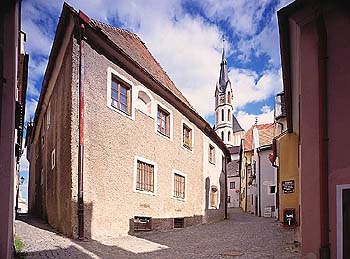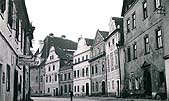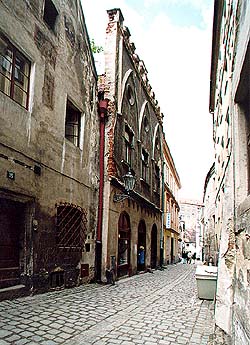History of Street Names in Český Krumlov
Náměstí Svornosti:
The first written mention is dated from 1443 when the square was
known as the market-place. This term was used even in the 16th
century and in the first half of the 17th century. Afterwards the
square was renamed in German - the Ringplatz and was called by this
name even in 1915. At present it is stated as náměstí Svornosti
(Square of Svornosti) The word svornost in Czech signifies union,
accord.
Horní ulice:
The first written mention about Horní ulice, or Upper Street,
occurred in 1511. From the 16th until the first half of 17th
century it was called Horní ulice. Afterwards it was renamed in
German to the Obere Gasse and from 1909 until 1918 it was called
the Roseggergasse in honour of a Styer poet Petr Rosegger. Then it
was again renamed Obere Gasse and today it is known as Horní
ulice.
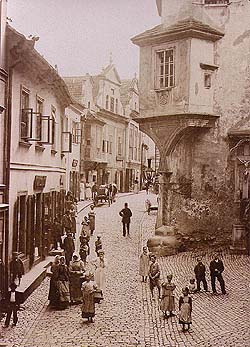
|

|
Kostelní ulice:
The first written mention about this lane below the school occured
in 1543. In the 16th century it was known as houses below the
school or houses below the church. In the 19th century it was
called Kirchengasse. Since 1915 it was known as Kirchengasse or
Kostelní ulice, translation Church St.
Šatlavská ulice:
From the 16th century this street was called the houses behind the
old Rathaus (old town hall square No.3) then as the Frohnfestgasse
in 19th century. In 1915 it was known under the name of
Frohnfestgasse (Frohnvest - public prison). Since 1918 it has been
known as Šatlavská ulice. Šatlava is an old term for jail in
Czech.

|

|
Radniční ulice:
Between the 16th and 17th centuries it was called the street from
Latrán to the market-place or from the market-place to Latrán by
walking. From the 18th until the beginning of the 19th century it
was called the Kasgasse. From the end of 19th century until 1915 it
was known as the Rathausgasse, then since 1918 has been known as
ulice Radniční, or Town Hall St.

|

|
Masná ulice:
From the 16th to 17th century it was called the houses at meat
shops (
History of Meat Market in Český Krumlov) then as the
Fleischgasse in the 19th century. Under this name it was known even
in 1915. Afterwards it was, and is, known as Masná ulice, which
translates into Butcher's St.

|

|
Kájovská ulice:
In the 16th and 17th centuries houses near No. 54 were known as Na
louži, while houses nearby Kájovská Gate No. 62 were called "u
Kájovské brány" (at the Kájov Gate), then as the Gojauergasse in
19th century. In 1915 it was known as the Gojauergasse. Afterwards
it is known as Kájovská ulice, or Kájov St. Kájov is a village near
Český Krumlov.

|

|
Na louži:
At the beginning of 16th century this name occured for houses No.
54, 67, 68. Around about 1900 the street was called Dr.
Nitscheplatz (in honour of Dr. Friedrich
Nitzche, the notary in Vyšší Brod, a deputy and honoured man in
his time). In 1915 it was known as the Dr. Nitscheplatz. Since 1918
it has been stated as Na louži. The name in Czech literally means
"on the puddle".
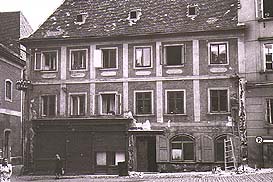
|

|
Panská ulice:
Until the 18th century it had no name, then in the 19th century it
was called Herrngasse. In 1915 it was known as the Nossbergergasse
( in honour of Matyáš Nossberger, a great local sponsor of the
poor). After 1918 it was known as Panská ulice, or Men's St.
Široká ulice:
Between the 16th and 17th centuries it was called the lowland or
back street, from 18th century it was known as the Breitegasse, and
under this name it was stated even in 1915. Afterwards it was known
as Široká ulice, Wide St.
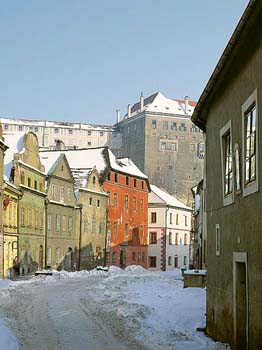
|
Dlouhá ulice:
In the 16th century it was thought of as a continuation of Široká
ulice (respectively lowland or back street). Between the 18th and
19th centuries it was known as Langegasse. Between 1902-1920 it was
called Franz Khemeter Gasse (in honour of a chairman of Český
Krumlov). After 1920 it is stated under the name Dlouhá ulice, Long
St.

|

|
Soukenická ulice:
In the 16th century it was called the middle street then between
the 18th and 19th centuries as Tuchmachergasse, even by this name
in 1915. Then the name of Soukenická ulice, Draper's St., was
stated.
Parkán:
The first written mention is from 1443. In the 16th century it was
known as Parkán or Parkgraben, then between the 18th and 19th
century as Parkgraben until 1915. Then it was known as Parkán - the
word indicates an area between the outer city walls in medieval
Czech language.
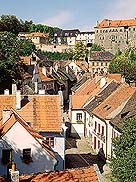
|

|

|
Na Ostrově:
From the 16th to the first half of the 17th century the name Na
Ostrově was used, then in the 18th century as Am Werdi and in 19th
century as Am Wirtl. In 1915 it was known as Am Wirtl and then as
Na Ostrově. The name literally means "on the island".
Linecká ulice:
Between the 16th and 17th centuries it was known as Kájovské
předměstí (Kájov suburb) then between the 18th and 19th centuries
as Gottesackergasse. In 1915 it was stated as the Linzerstrasse and
today as Linecká ulice.
Rybářská ulice:
In the first written mention it is stated as Rybářská ulice in 1528
then between 17th-20th centuries as Rybářská and Fischergasse
alternately. In 1915 it was known under the name of Fischergasse.
Today it is known as Rybářská ulice, meaning Fisherman's St.
Plešivec:
This is a suburb as well as a street. From the 16th century it was
known as Plešivec or Flechberg. In 1915 it was stated under the
name of Flossberg, today as Plešivec. The word has a connotation
towards bald-headedness.

|

|
Latrán:
This is a suburb as well as a street. The first mention was noted
in a land and duties register of Rosenberg from the 1370's. It
used to be stated in Czech as Latrán or in German as Latron by
turns.

|

|

|
Zámecké schody:
In the 16th century they were called the Hofperk, then as the
Schlosstiege in the 19th century and as the Hofstiege in 1915.
Afterwards they were known as Zámecké schody, meaning Castle
Stairs.

|
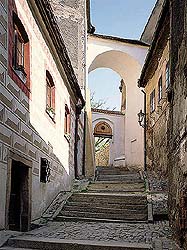
|
Nové Město:
The name occured in 15th century . In German it is called the
Neustadt (New Town).
V jámě:
The name first occured in the 16th century . (In the Pit).
Klášterní:
The street didn't have its own name until the beginning of the
20th century. In 1915 it was stated under a name the
Turkowizergasse (in honour of Austrian priest who was in service
also in Český Krumlov who used to make financial donations to
support poor students). Since 1918 it has been known as Klášterní
ulice (Church St.).
(kol.)



